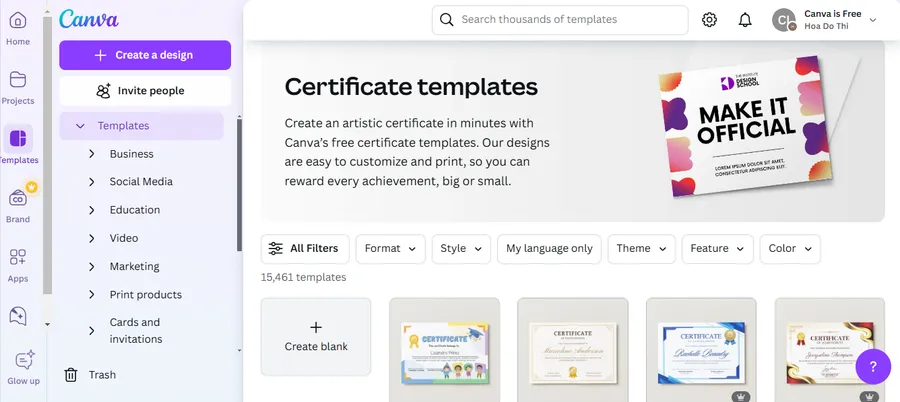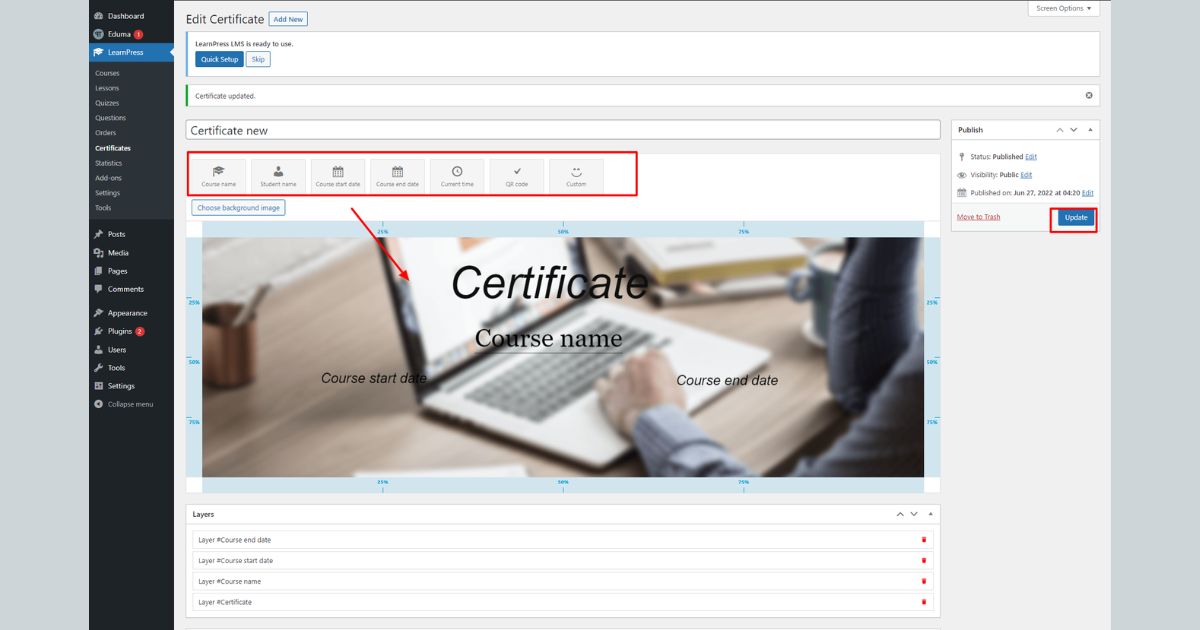Online courses and training programs have become increasingly popular.
They offer flexibility and convenience for learners, allowing them to acquire new skills and knowledge at their own pace.
As the demand for online learning grows, so does the need for efficient and reliable systems to manage and certify learners’ achievements.
One effective way to do this is by offering automated certification for course completion.
Automated certification for course completion is a system that automatically generates and distributes certificates to students who complete your online course.
This saves you time and effort and provides your students instant gratification and a verifiable credential.
Eduma – Education WordPress Theme
We provide an amazing WordPress theme with fast and responsive designs. Let’s find out!
This blog post will guide you through the steps of creating an automated certification for course completion.
We will explore the benefits, discuss the key considerations, and provide practical tips for implementing this system effectively.
Benefits of Automated Certification for Course Completion

Implementing an automated certification system offers numerous benefits for both learners and institutions:
Increased Efficiency: Automation eliminates the manual effort involved in generating and distributing certificates, freeing up valuable time for instructors and administrators to focus on other essential tasks.
Improved Accuracy: Automated systems minimize the risk of human error in generating certificates, ensuring that all information is accurate and consistent.
Enhanced Learner Satisfaction: Learners receive their certificates promptly upon completion, providing instant gratification and validating their achievements.
Reduced Costs: Automation eliminates the need for printing and mailing physical certificates, saving on material and postage costs.
Improved Brand Image: A professional-looking certificate with automated issuance enhances the credibility and perceived value of the course.
Better Data Management: Automated systems can track and store certification data, providing valuable insights into learner progress and course effectiveness.
Key Considerations for Automated Certification
Before implementing an automated certification system, there are several key considerations to keep in mind:
Learning Management System (LMS)
Ensure your LMS has the capability to support automated certification.
Many popular LMS platforms offer built-in features or integrations with third-party tools for this purpose.
Certificate Design
Create a professional and visually appealing certificate template that aligns with your institution’s branding.
Include essential elements such as the learner’s name, course name, date of completion, and issuer information.
Triggering Mechanism
Determine the criteria for triggering the automated certification process.
This could be based on completing all modules, achieving a passing grade, or meeting specific requirements within the course.
Delivery Method
Decide how the certificates will be delivered to learners.
Options include email attachments, downloadable links within the LMS, or integration with digital credential platforms.
Security Measures
Implement security measures to prevent unauthorized access and fraudulent certificate generation.
This may involve user authentication, data encryption, and secure storage of certificates.
5 Simple Steps to Create an Automated Certification for Course Completion
1. Choose the Right Platform for Automated Certification for Course Completion
The first step in creating an automated certification for course completion is choosing the right platform. Several platforms offer this functionality, each with strengths and weaknesses.
Some popular options include:
Learning Management Systems (LMSs)

LMSs such as SkillTrans, Moodle, Thinkific, and Teachable offer built-in features for creating and distributing certificates.
These platforms are a good option if you already use an LMS for your course.
WordPress LMS Plugins

Another powerful option is LearnPress, our WordPress LMS plugin.
LearnPress is a free and open-source plugin that provides a comprehensive solution for creating and selling online courses.
It offers seamless integration with WordPress and a wide range of features, including automated certificate generation.
With LearnPress, you can easily create and customize certificates, define completion criteria, and automate the delivery process.
Dedicated Certification Platforms
Several platforms specialize in creating and managing certifications.
These platforms offer more advanced features than LMSs, such as custom branding and advanced reporting.
Standalone Tools
Some standalone tools can be integrated with your existing website or platform to automate the certification process.
These tools are a good option if you don’t need a full-fledged LMS or certification platform.
When choosing a platform, consider your needs and budget. If you only need basic certification functionality, an LMS may be sufficient.
However, if you need more advanced features or want to brand your certificates, you may need to consider a dedicated certification platform or standalone tool.
2. Design Your Certificate for Automated Certification for Course Completion

Once you’ve chosen your tools, it’s time to design your certificate.
Your certificate should be visually appealing, and professional, and reflect the value of your course.
Here are some key elements to consider:
- Layout: Choose a clean and uncluttered layout that highlights the essential information.
- Content: Include the student’s name, course name, completion date, and any relevant credentials or logos.
- Branding: Incorporate your brand colors, fonts, and logo to maintain consistency.
- Security: Consider adding security features, such as a unique certificate ID or a QR code, to prevent fraud.
You can use graphic design software like Canva or Adobe Photoshop to create your certificate template.
Alternatively, many certificate generation tools offer pre-designed templates that you can customize.
3. Set Up Your Automated Certification for Course Completion
With your certificate designed, it’s time to set up your automated certification for the course completion system.
This involves integrating your chosen tools and configuring the automation process.
If you’re using an LMS with built-in certificate features, the setup process is usually straightforward.
You’ll need to create a certificate template, define the criteria for earning the certificate, and configure the automation settings.
If you’re using separate certificate generation tools or automation platforms, you’ll need to connect them to your course platform and configure the triggers and actions for certificate generation.
For example, you can set up a trigger that automatically generates a certificate when a student completes all course modules or achieves a passing grade.
4. Test Your Automated Certification for Course Completion

Before launching your course, testing your automated certification for course completion process is important.
This will help you identify and fix any issues before they affect your learners.
You can test the process by enrolling in your course as a test student and completing all the requirements.
If everything is set up correctly, you should receive a certificate automatically.
You should also test the email notifications to ensure they are sent correctly.
This will help you ensure that your learners receive their certificates promptly.
5. Launch Your Course and Monitor Your Automated Certification for Course Completion

Once you have tested your automated certification for course completion process, you can launch your course.
Monitoring the process and tracking the number of certificates issued is important.
You should also keep an eye on learner feedback and make any necessary adjustments.
This will help you ensure that your automated certification for course completion process is running smoothly and that your learners have a positive experience.
Common Issues with Automated Certification for Course Completion
While automated certification for course completion offers many benefits, there are a few common issues that you may encounter:
Technical issues: Technical issues with your chosen platform can prevent certificates from being generated or distributed correctly.
Incorrect data: If the data used to generate certificates is incorrect, the certificates may contain errors.
Email delivery issues: Email delivery issues can prevent learners from receiving their certificates.
Learner confusion: Learners may be confused about the certification process or how to access their certificates.
Tips for Troubleshooting Automated Certification for Course Completion
Here are a few tips for troubleshooting common issues with automated certification for course completion:
Test your process thoroughly: Testing your process before launching your course will help you identify and fix any issues before they affect your learners.
Use clear and concise instructions: Provide clear and concise instructions to your learners about the certification process.
Monitor your system regularly: Monitor your system regularly to identify and fix any issues that may arise.
Provide support to your learners: Offer support to your learners if they have any questions or problems with the certification process.
Automated Certification for Course Completion with LearnPress
With the Certificates Add-on for LearnPress, instructors can easily set up automated certifications for course completion.
Note: You will need LearnPress to use Certificates Add-on for LearnPress. If you haven’t tried LearnPress yet, give us a chance and try it now, it’s completely free.
This feature allows students to instantly receive a professionally designed certificate once they meet course requirements, streamlining the certification process and enhancing learner satisfaction.

The add-on offers customizable templates to match your branding and supports automated delivery, eliminating manual distribution and reducing errors.
Automated certification through LearnPress provides a convenient and efficient way for students to showcase their achievements and for educators to add value to their courses with minimal effort.
In addition, we also regularly update the frontend and pre-builds of Certification Add-on for LearnPress on Eduma demos – our #1 education WordPress theme, you can check out our new interface right away at Eduma Online Learning.

Conclusion
Automated certification for course completion is a valuable tool for any course creator looking to enhance their students’ learning experience and streamline their administrative tasks.
By choosing the right tools, designing a professional certificate, and implementing an efficient automation process, you can give your students a sense of accomplishment and a verifiable credential they can proudly share.
Read More: 5 Best Ways to Optimize Your Online Course Structure
Contact US | ThimPress:
Website: https://thimpress.com/
Fanpage: https://www.facebook.com/ThimPress
YouTube: https://www.youtube.com/c/ThimPressDesign
Twitter (X): https://twitter.com/thimpress


